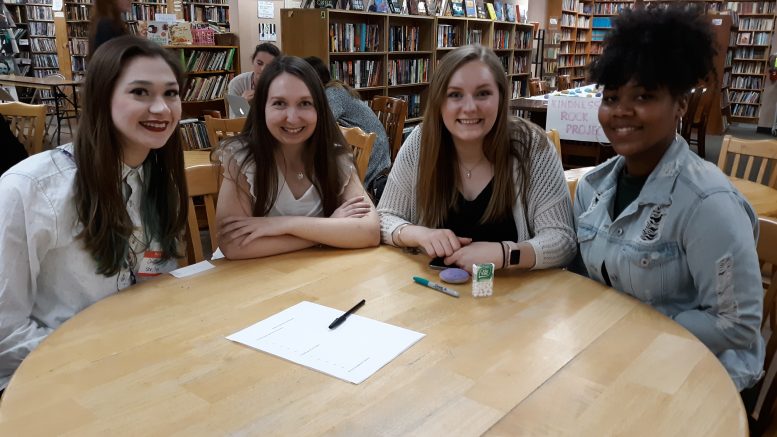By JAN LARSON McLAUGHLIN
BG Independent News
For centuries, a portion of the female population has tried to reach physical perfection, whatever that may have been at the time – plump, big busted, muscular or twig-like.
But the difference nowadays is that those failing to peak at perfection can be victims of vicious criticism on social media.
And while the images of the ideal body once appeared on the front of monthly women’s magazines, the photos now appear in rapid succession on Instagram or other social media platforms.
So a group of Bowling Green State University students in professor John Zibbel’s Creative Learning Environments class, presented their “Body Positivity Project” on Friday at Grounds for Thought. The event was designed to help young girls feel comfortable and connect with their peers.
The students – Caitlin Palmer, Brennah Kershner, Kaitlin Mendenhall and Vivica Hayward – want women and men to know that their bodies don’t have to look like the photos that bombard them every day.
“It’s about feeling comfortable in who you are, not letting anyone dictate how you feel about yourself,” Hayward said. “Be true to yourself. It’s your body. No one else deserves a say.”
The body positivity effort advocates the acceptance of all bodies no matter the size or imperfections. The movement addresses the unrealistic beauty standards set by society, and stresses the need to accept physical characteristics that don’t meet the ideal.
“I wanted to have an event where everyone can see how important they are,” Mendenhall said.
That they are more than their bodies.
“There is no ideal. There is no normal,” Kershner said.
But social media puts pressure on people – especially young women. There are clear expectations today of ideal weight, hairstyles, and complexions.
“Everyone wants to be an Instagram model today,” Kershner said.
“Everybody is a beauty guru all of the sudden,” Palmer said. “There is a huge pressure on guys and girls to be the ideal man or woman.”
Adolescent females are particularly susceptible to societal standards shown on social media.
“They want to look like everyone else does,” Mendenhall said.
Women posting on sites like Instagram sometimes feel even worse about themselves if their photos draw negative comments or if their posts don’t get 100 more more “likes.”
“You’re wanting it to be something enough people like,” Mendenhall said.
Women should refuse to pick apart imperfections in each other, Kershner stressed.
“Everybody wants to body shame each other. We should be lifting each other up,” she said. “We all come in different shapes and sizes, but that doesn’t mean we have to go after each other about how we look.”
Social media puts people on pedestals, then other people try to knock them off, Palmer said.
Many teenage girls are suffering from a lack of body positivity, Mendenhall said.
“I feel like girls don’t get to have the awkward stage anymore,” without being a target of cruel comments as they experiment with coloring their hair or trying a weird eye shadow, she said.
And some very young girls are “dieting” due to social pressures, Kershner said.
“There is no diet you need to be on when you are so young,” she said.
The pressures also come with the items used to accessorize women’s bodies, the students said. The right make-up, the boots that all the popular girls are wearing, the latest cell phones.
For Palmer, it started in sixth grade with a girl who couldn’t afford a Coach purse.
“Brands are status symbols,” she said. “It’s always what’s trending.”
For Hayward, Coach purses were not even an option. “I was always behind the curve,” she said.
But she did feel the pressure to reach for “European beauty standards.” For Hayward, an African American girl in a school of primarily white students, that meant spending one-and-a-half hours straightening her hair. “I was looking at people with long blond hair.”
But once she came to college, Hayward became more comfortable with herself.
“I laugh and cringe at the same time,” when she looks back at photos from high school. “I don’t have to be like everybody else.”

